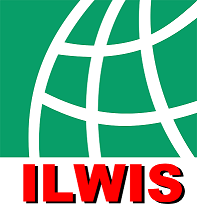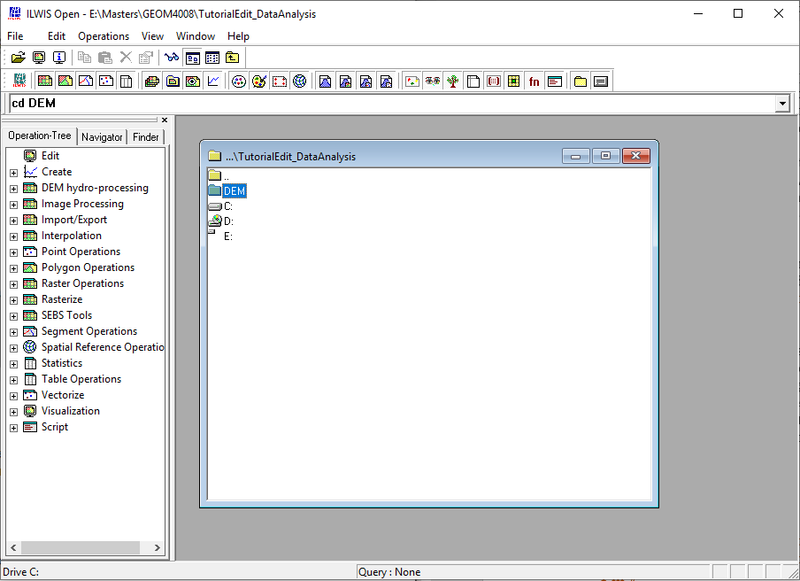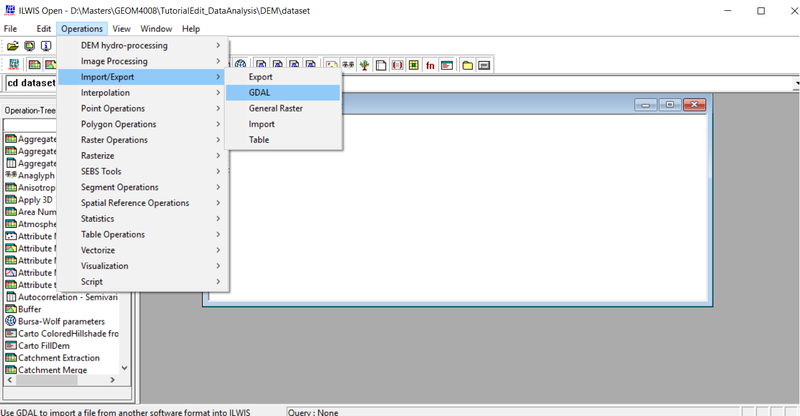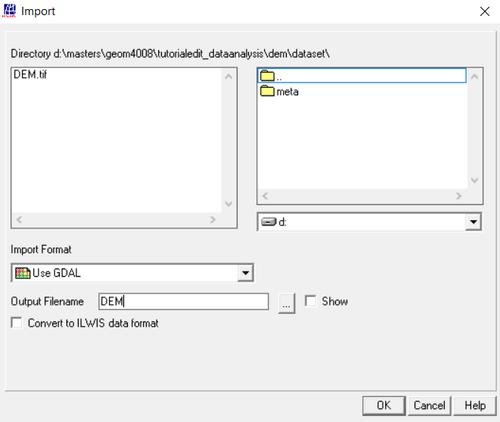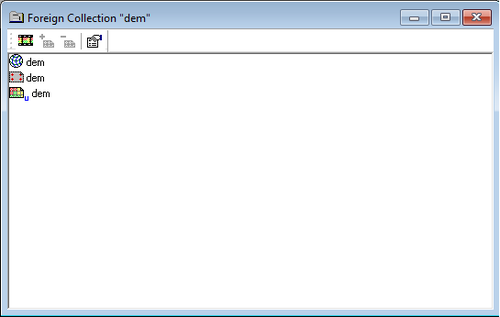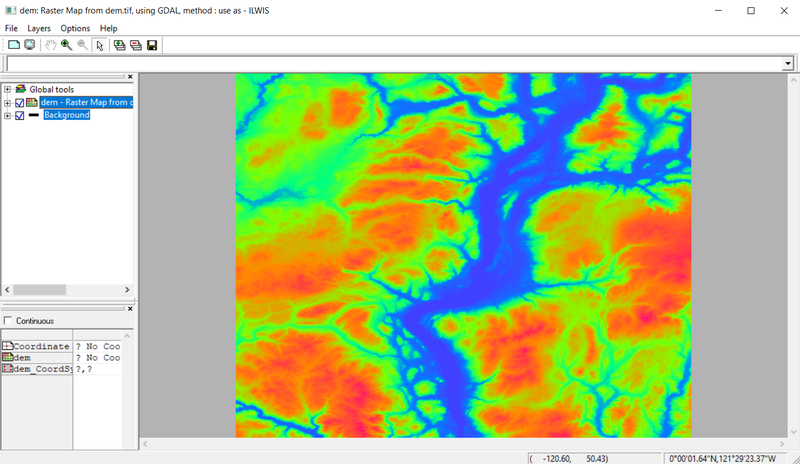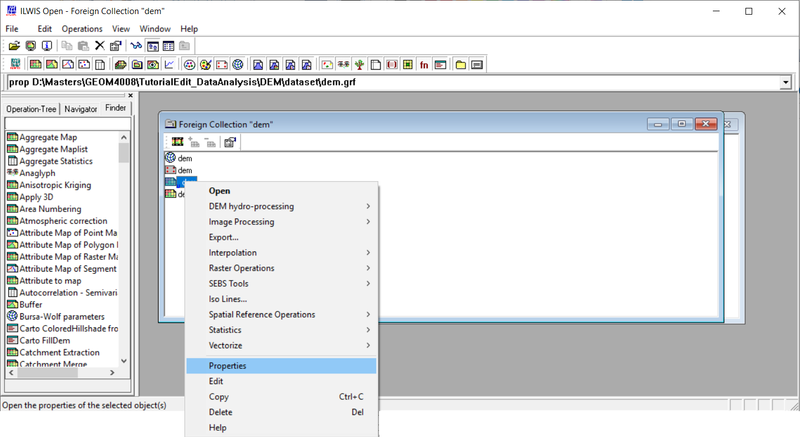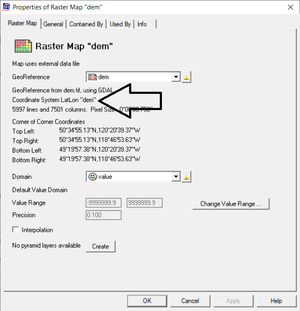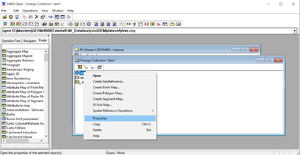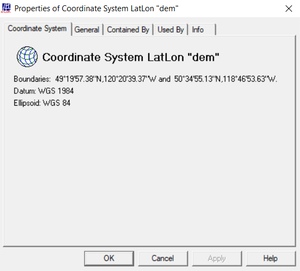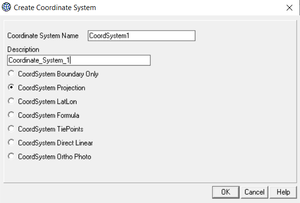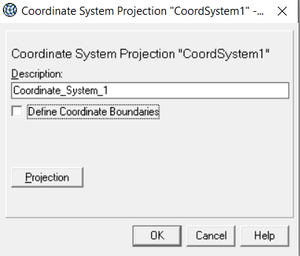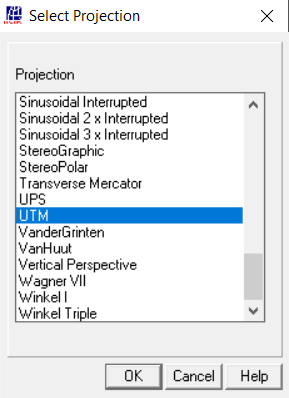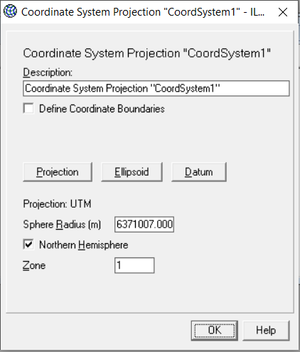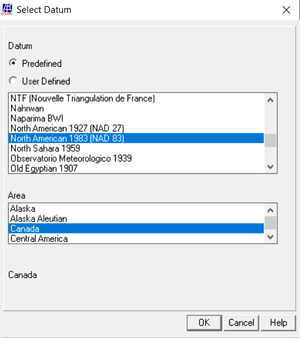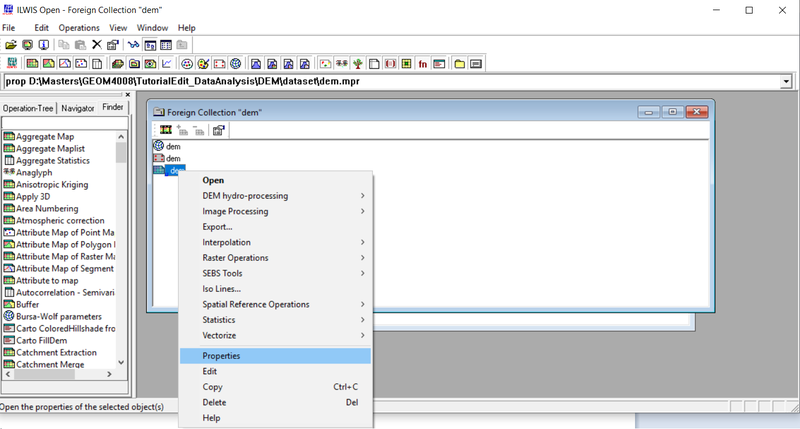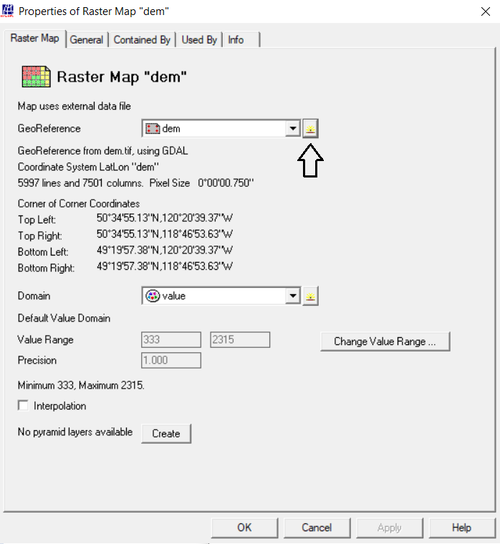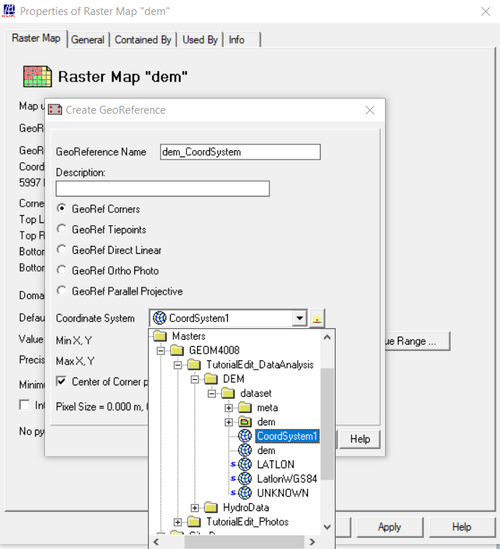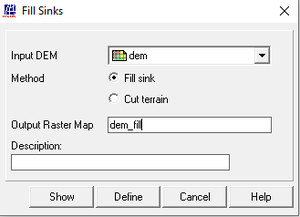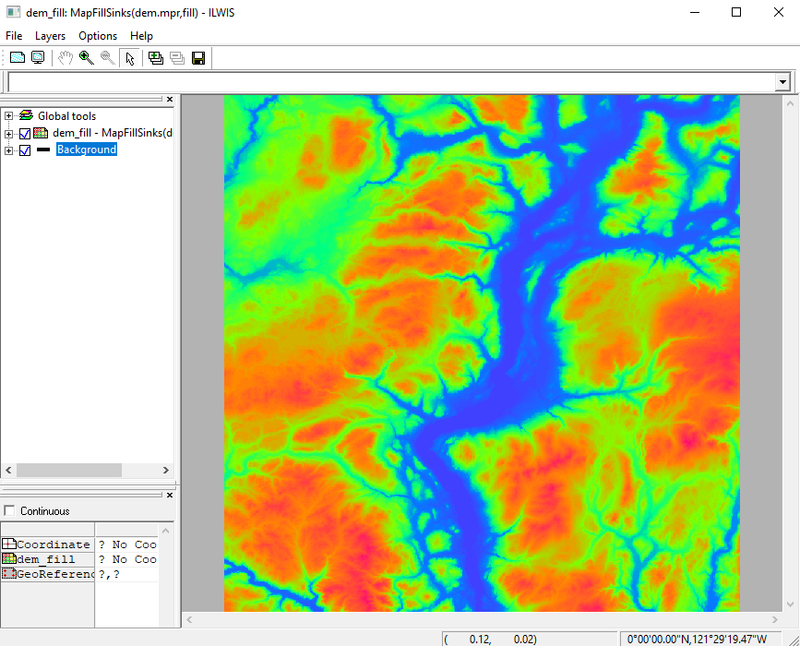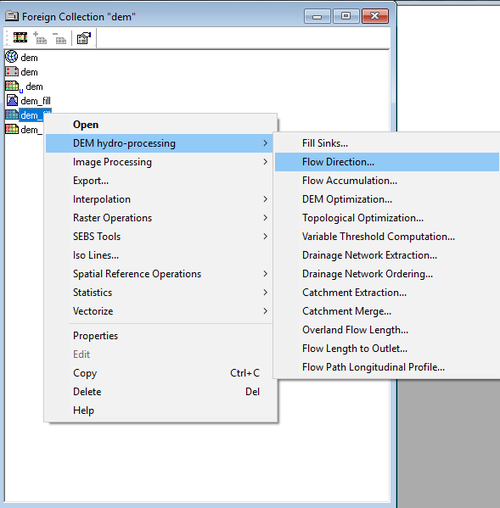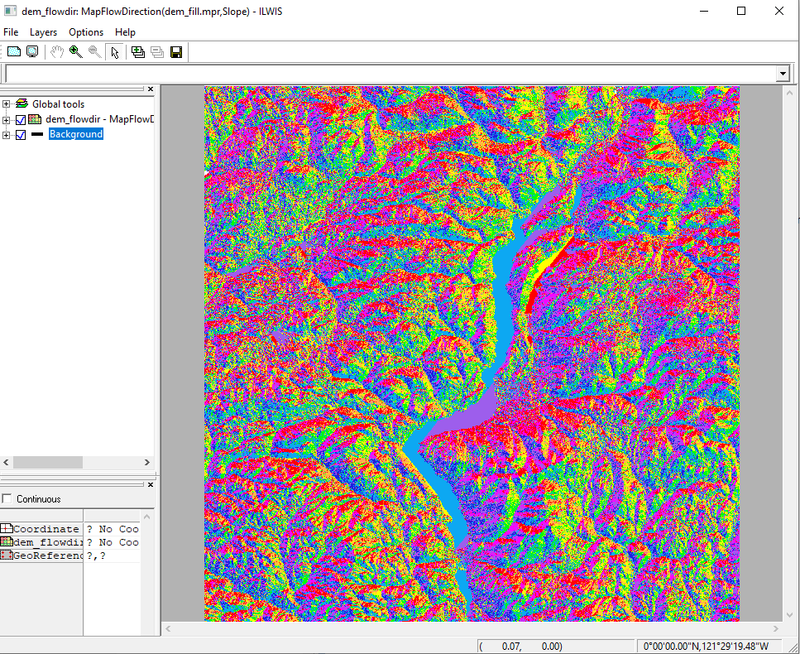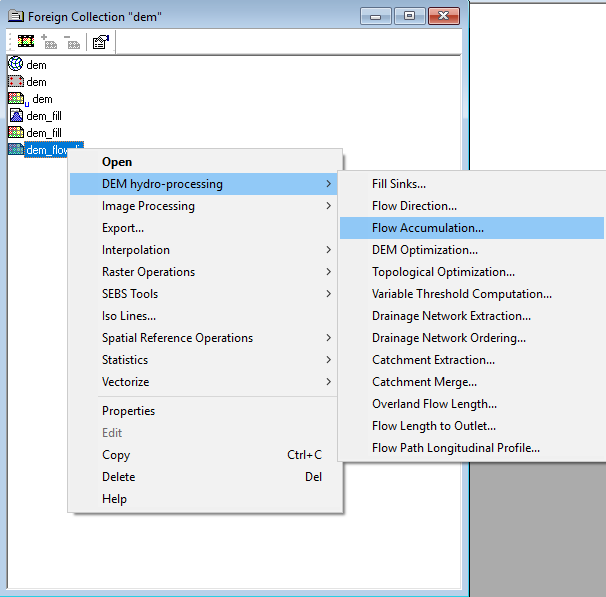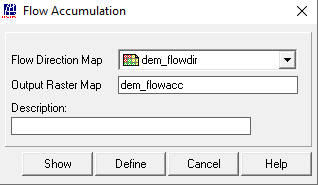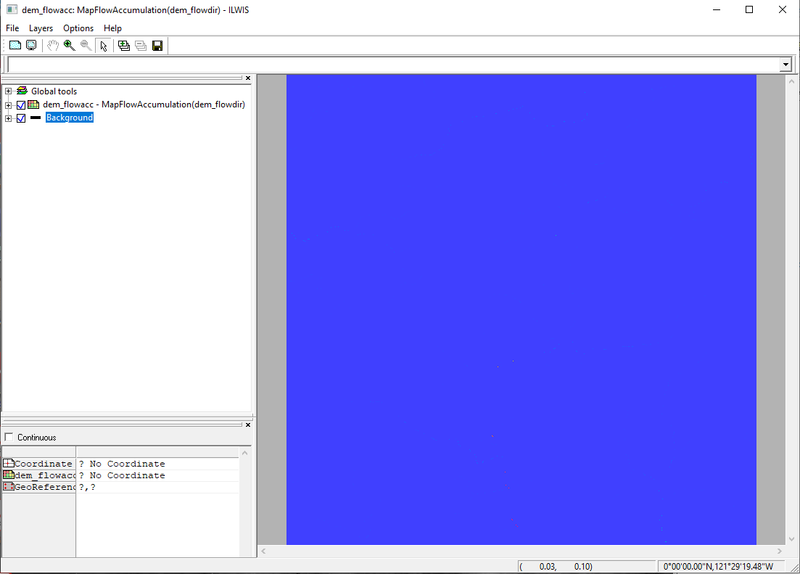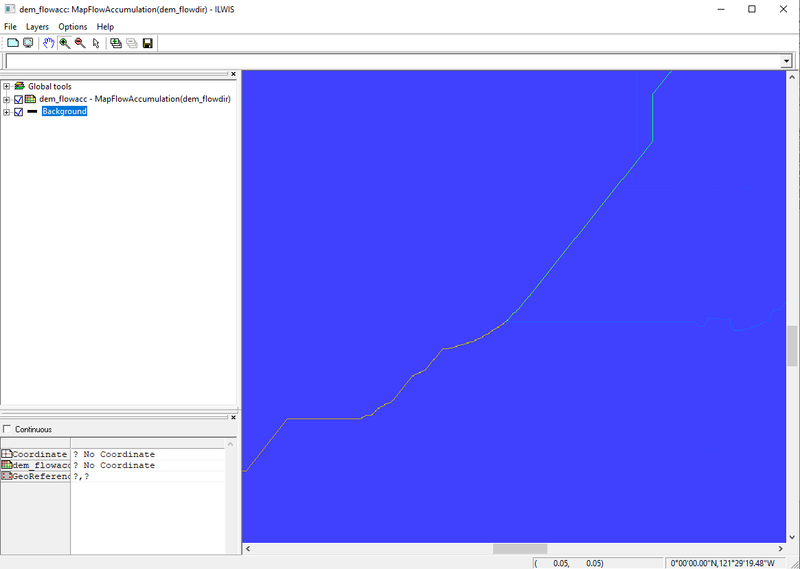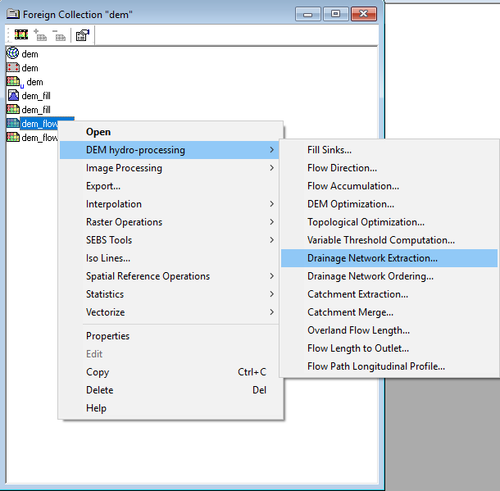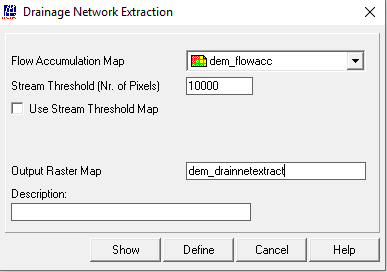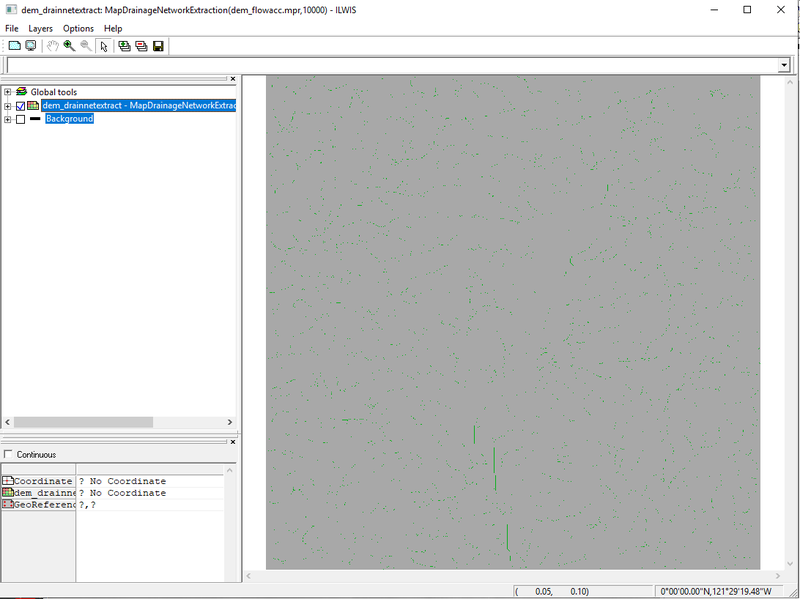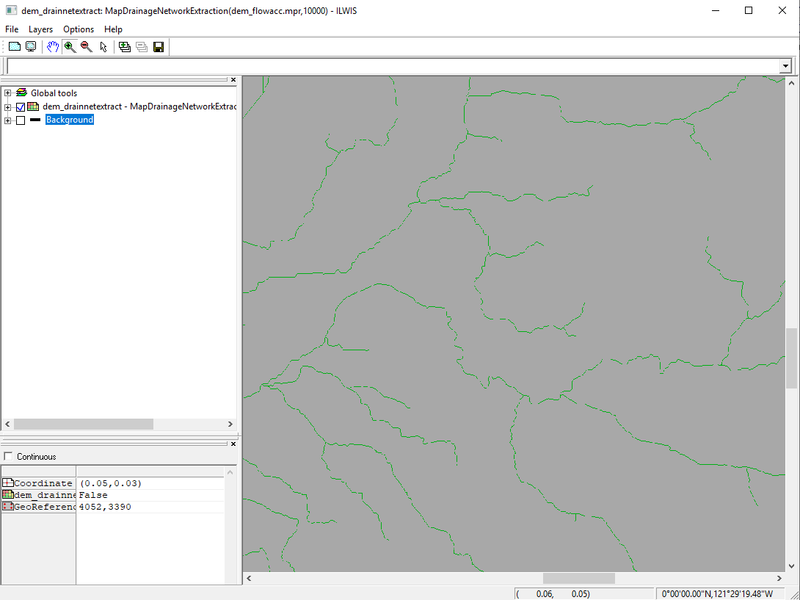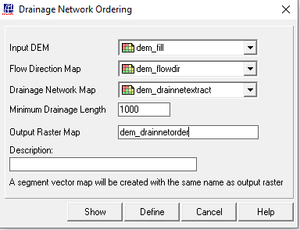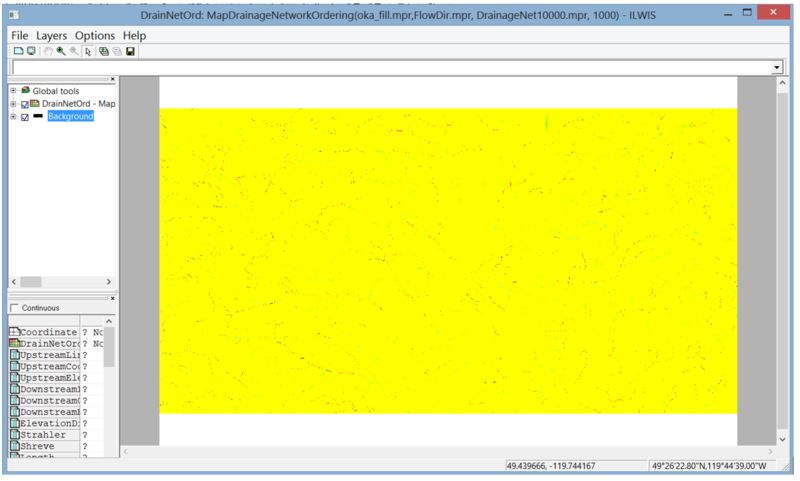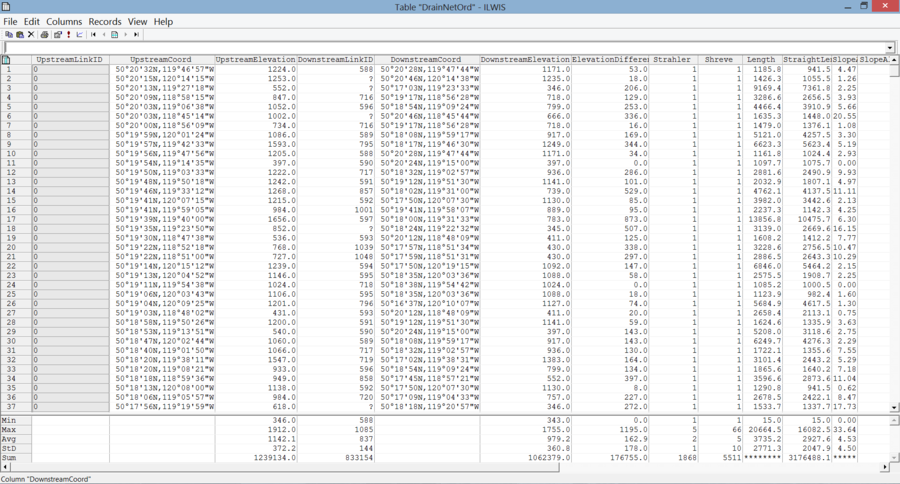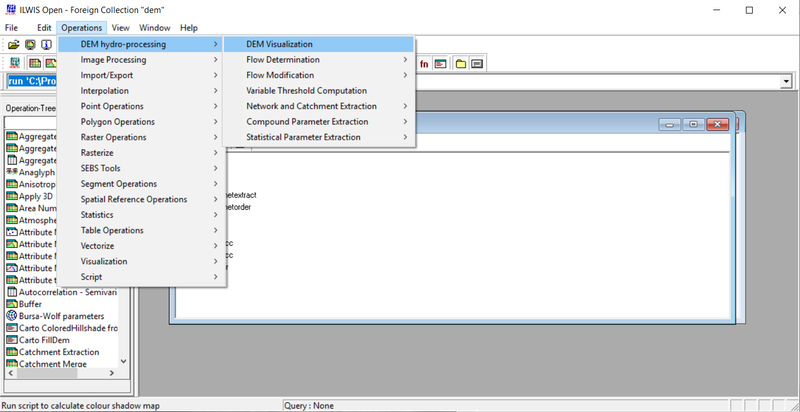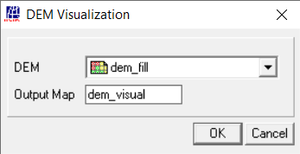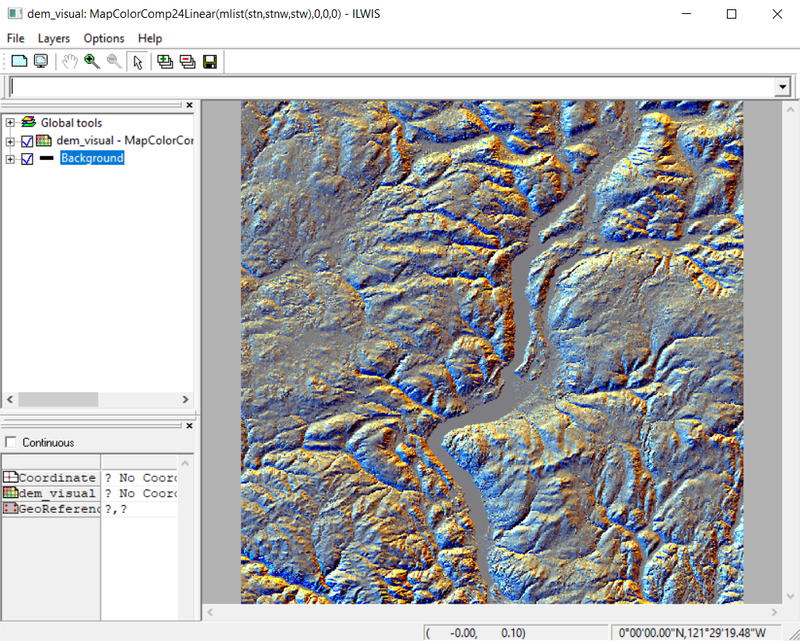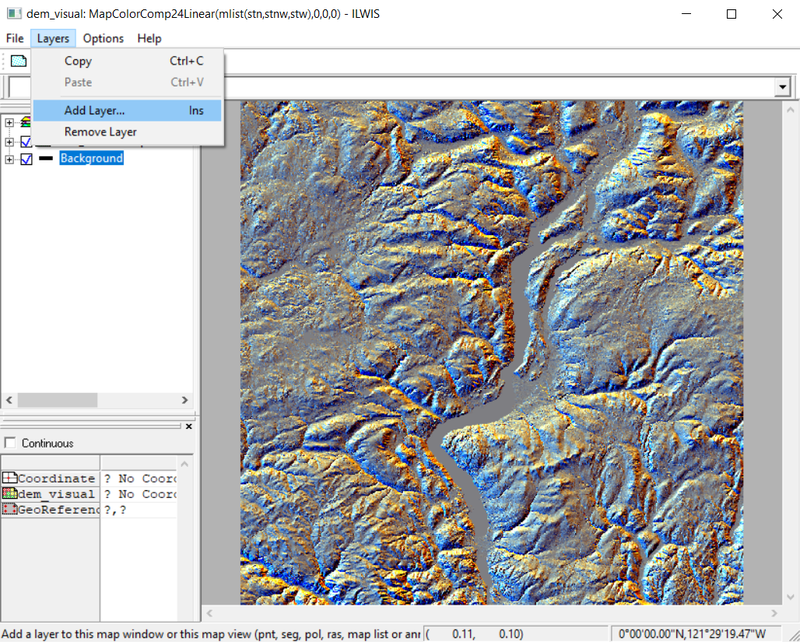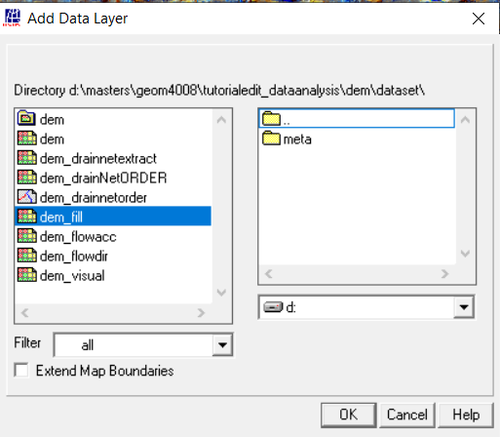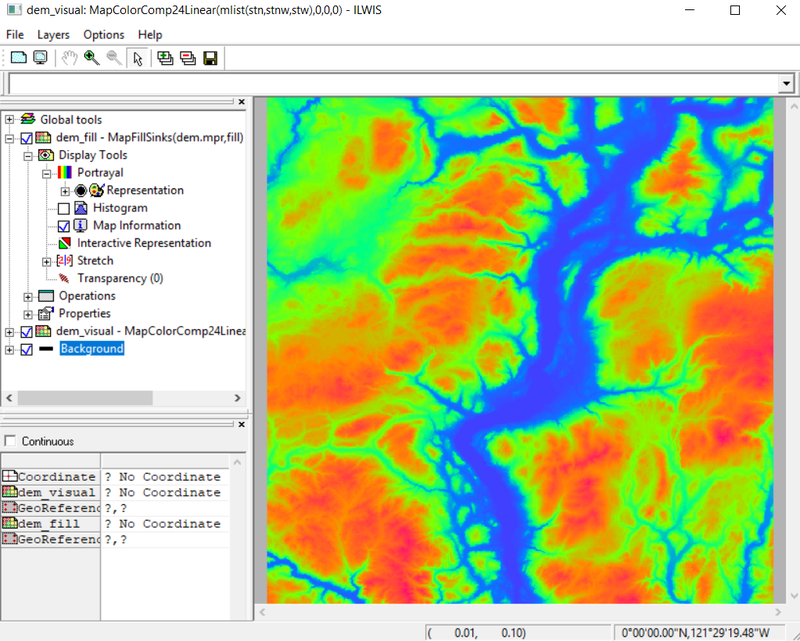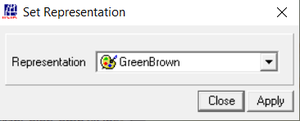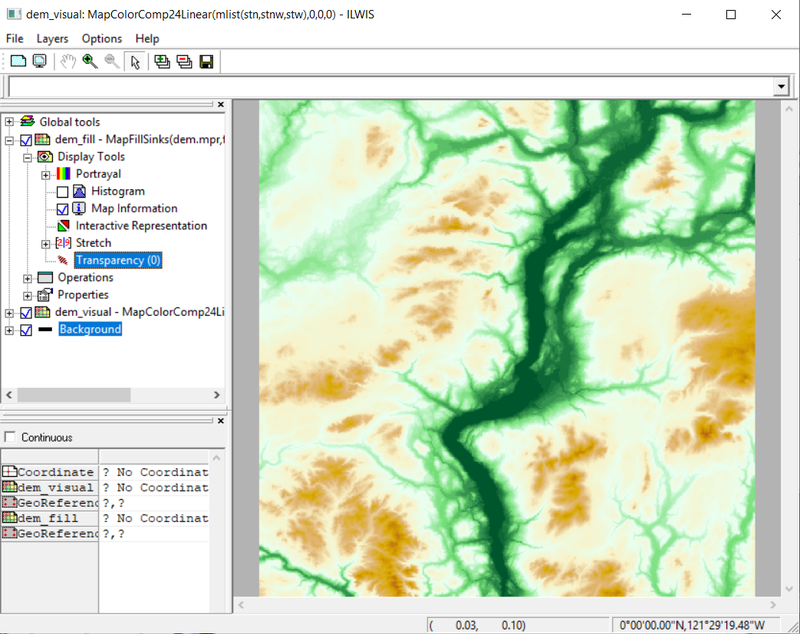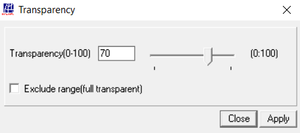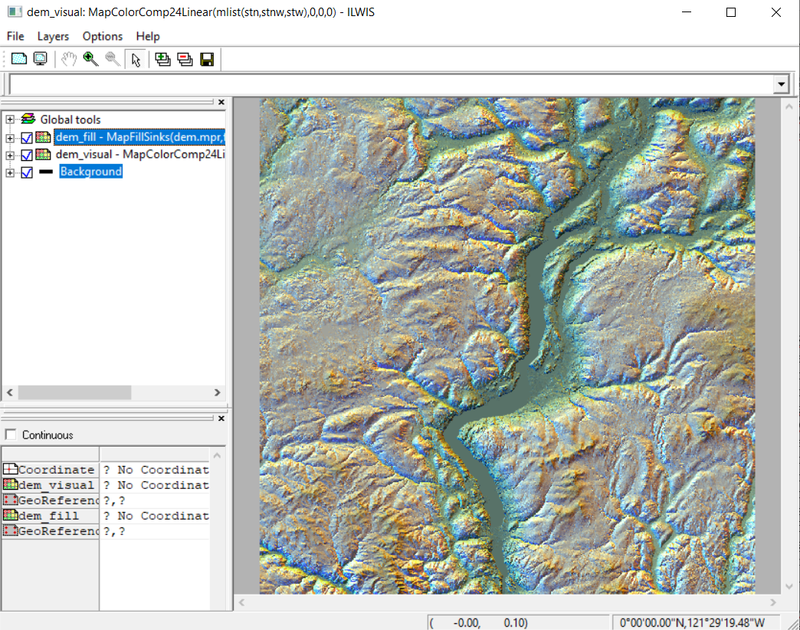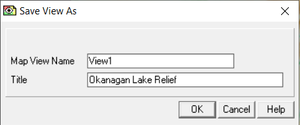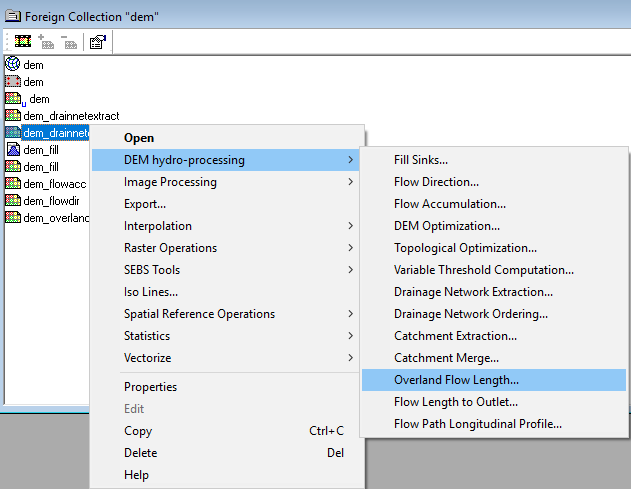Difference between revisions of "Exploring Hydrological Analyses using ILWIS"
m (→Conclusion) |
|||
| (26 intermediate revisions by 2 users not shown) | |||
| Line 1: | Line 1: | ||
==Purpose== |
==Purpose== |
||
| + | [[File:ilwis_logo.png|frame|ILWIS Logo]] |
||
This Wiki tutorial has been produced for the purpose of exploring and describing the methods used for hydrological analyses in ILWIS (a FOSS4G program). The objective of this tutorial is to provide users with a better understanding of how the hydrological analyses within ILWIS works, in addition to providing the instructions necessary to reach the desired output for their study region. Additionally, this tutorial will allow for comparison of ILWIS and SAGA GIS, using the same data for analysis as the [http://gracilis.carleton.ca/CUOSGwiki/index.php/Exploring_Hydrological_Analyses_using_SAGA_GIS Exploring Hydrological Analyses using SAGA GIS] tutorial from 2013. |
This Wiki tutorial has been produced for the purpose of exploring and describing the methods used for hydrological analyses in ILWIS (a FOSS4G program). The objective of this tutorial is to provide users with a better understanding of how the hydrological analyses within ILWIS works, in addition to providing the instructions necessary to reach the desired output for their study region. Additionally, this tutorial will allow for comparison of ILWIS and SAGA GIS, using the same data for analysis as the [http://gracilis.carleton.ca/CUOSGwiki/index.php/Exploring_Hydrological_Analyses_using_SAGA_GIS Exploring Hydrological Analyses using SAGA GIS] tutorial from 2013. |
||
| + | This project will focus on hydrological analysis of Okanagan Lake, a popular tourist destination in British Columbia, Canada. The tutorial will cover topics such as filling sinks, flow direction, DEM visualization and drainage network mapping through the use of ILWIS hydrological analysis tools. |
||
| − | ==Introduction to ILWIS and the Project Tutorial== |
||
| − | ILWIS stands for "Integrated Land and Water Information System". It is an open source Geographic Information System software program that was designed to be a user-friendly integrated software that contains both raster and vector processing capabilities, allowing for both analyses on remotely sensed images, vector maps and numerous spatial modeling abilities. ILWIS was developed by the International Institute for Aerospace Survey and Earth Sciences (ITC) in The Netherlands. This tutorial will focus on its ability to use Digital Elevation Models (DEMs) to run hydrological analyses of a study region. More information about this product can be found on the [http://www.ilwis.org/ ILWIS Website] |
||
| + | ==Introduction to ILWIS== |
||
| − | [[File:ilwis_logo.png]] |
||
| + | ILWIS stands for "Integrated Land and Water Information System". It is an open source Geographic Information System software program that was designed to be a user-friendly integrated software that contains both raster and vector processing capabilities, allowing for both analyses on remotely sensed images, vector maps and numerous spatial modeling abilities. ILWIS was developed by the International Institute for Aerospace Survey and Earth Sciences (ITC) in The Netherlands. This tutorial will focus on its ability to use Digital Elevation Models (DEMs) to run hydrological analyses of a study region. More information about this product can be found on the [https://52north.org/software/software-projects/ilwis/ ILWIS Website] |
||
| − | |||
| − | This project will focus on hydrological analysis of Okanagan Lake, a popular tourist destination in British Columbia, Canada. The tutorial will cover topics such as Aspect mapping, Slope mapping, Watershed Delineation mapping and Wetness Index mapping through the use of ILWIS hydrological analysis tools. |
||
==Methods== |
==Methods== |
||
| − | === |
+ | ===Software Download and Installation=== |
| + | ILWIS 3.8.5 can be downloaded for free from the [https://github.com/52North/Ilwis3Downloads GitHub page for 52 North]. This is the most recent version of ILWIS 3 and was released on September 3, 2015. Since the release of this version, the ITC has released ILWIS 4. It is likely that new versions of ILWIS 3 will eventually stop being released, as the capabilities of ILWIS 4 become greater. More information about ILWIS 4 can be found on the [http://ilwis.itc.utwente.nl/wiki/index.php/Main_Page ILWIS 4] website. |
||
| + | ===Data Sourcing=== |
||
| − | In order to carry out this exercise, a DEM of the area of interest is needed. For this project a open data DEM was obtained using the [http://www.geogratis.gc.ca/site/eng/extraction Geospatial Data Extraction] tool created by Natural Resources Canada. |
||
| + | In order to carry out this exercise, a DEM of the area of interest is needed. For this project an open data DEM was obtained using the [http://maps.canada.ca/czs/index-en.html Geospatial Data Extraction Tool] created by Natural Resources Canada. |
||
| − | + | Digital Elevation Models for locations outside of Canada can be obtained using the [http://earthexplorer.usgs.gov/ EarthExplorer Tool] created by the United States Geological Survey (USGS). |
|
| − | |||
| − | This tutorial explores the hydrological toolset for ILWIS, but the use of open-source program QGIS is needed as well. This can be downloaded from [https://www.qgis.org/en/site/forusers/download.html the QGIS website]. |
||
| − | |||
| − | ===Getting Started=== |
||
| − | Before starting any analysis, create your working folder and ensure all data needed for the exercise are in this folder. Keeping all your data in one folder will make analysis easier. |
||
===Starting ILWIS=== |
===Starting ILWIS=== |
||
| + | '''Before starting any analysis, create a working folder and ensure all data needed are in this folder. Keeping all your data in one folder makes analyses easier.''' |
||
| − | ILWIS 3.08.03 can be downloaded for free from [http://52north.org/communities/ilwis/ilwis-open/download 52 North].The newer version of ILWIS 3.08.04 is available at the time of writing this tutorial, but do not download this one, as a bug does not allow you to import DEMs into that version. In the future, newer versions may also be possible, but the tutorial will need to be verified on them. |
||
| + | ---- |
||
| − | |||
| − | *Ensure that ILWIS 3. |
+ | *Ensure that ILWIS 3.8.5 is properly installed on your computer |
| − | *Locate ILWIS from the |
+ | *Locate ILWIS from the program list and double click on the icon to launch program |
*ILWIS main page will open |
*ILWIS main page will open |
||
*Use the ILWIS Navigator Tab to locate your working folder. The Navigator lists all drivers and directories. |
*Use the ILWIS Navigator Tab to locate your working folder. The Navigator lists all drivers and directories. |
||
| − | [[File: |
+ | [[File:ILWIS_Interface2.png|800px]] |
| − | |||
| − | Figure 1: Screenshot of ILWIS Interface |
||
| + | ''Figure 1: Screenshot of ILWIS Interface'' |
||
| − | ===Projecting a DEM in QGIS=== |
||
| − | Projecting in ILWIS did not work, so QGIS (another open source GIS software) was used instead. These following steps explain how to load a DEM into QGIS, assign a projection, and export the DEM to be used in other software (e.g. ILWIS) |
||
| − | 1) Download QGIS and open the program. |
||
| + | ===Importing a DEM=== |
||
| − | 2) Add your DEM using the '''Add Raster Layer''' tool (Figure 2). You will have to navigate to the working folder and select the DEM. |
||
| + | Before any analysis can be completed, a DEM of the region of interest must be imported into ILWIS. |
||
| + | :1) Click Operations --> Import/Export --> GDAL (Geospatial Data Abstraction Library) |
||
| − | [[File: |
+ | [[File:ImportDEM_1.png|800px]] |
| − | ''Figure 2 - |
+ | ''Figure 2 - Finding the import tool in ILWIS'' |
| − | 3) To reproject your DEM click '''Raster''' -> '''Projection''' -> '''Assign Projection''' |
||
| + | ::* An Import window will open |
||
| − | 4) A new window will open (Figure 3) called '''Assign Projection''', within this window the DEM to be projected is selected for input file |
||
| − | [[File: |
+ | [[File:ImportDEM_2.png|500px]] |
| − | ''Figure 3 - |
+ | ''Figure 3 - ILWIS import window'' |
| − | 5) Click '''Select...''' under desired srs in the '''Assign Projection''' window and a new '''Select Desired SRS''' window will open (Figure 4). |
||
| + | :2) Click to the DEM you want to import and ensure that the import format is set to Use GDAL. |
||
| − | 6) Within this window select the desired coordinate system. Click OK. |
||
| − | (note: For the following hydrological analyses, the coordinate system chosen needs to be in planar coordinates (units of metres), |
||
| − | not in polar coordinates (units of degrees)) |
||
| + | :3) Give your Output DEM a name and click OK. |
||
| − | [[File:QGIS Select desired SRS.png|350px]] |
||
| + | ::* The new DEM (compatible in ILWIS) will save in your working directory |
||
| − | ''Figure 4 - Desired SRS window'' |
||
| + | :4) To view your DEM double-click on the DEM to open the Foreign Collection window. |
||
| − | 7) A new DEM will be added to the QGIS interface with the desired projection |
||
| + | [[File:ForeignCollectionWindow.png|500px]] |
||
| − | 8) The new DEM can be exported by right-clicking it and selecting '''Save as...''' |
||
| + | ''Figure 4 - ILWIS foreign collection window'' |
||
| − | 9) A window called '''Save raster layer as...''' will open. Under '''Save as''' browse to the desired folder location for your projected DEM and rename it. |
||
| − | [[File:Save Raster Layer As QGIS.png|450px]] |
||
| + | :5) In the foreign collection window, double-click on the raster layer icon to open the DEM. |
||
| − | ''Figure 5 - Save Raster Layer As window'' |
||
| + | :::: [[File:ForeignCollectionWindow2.png|100px]] |
||
| + | :::: ''Figure 5 - ILWIS raster icon'' |
||
| − | 10) Click Save. A projected DEM for the region of interest is now saved and can be loaded into ILWIS. |
||
| + | ::* The raster you have imported will open |
||
| − | ===Importing DEMs into ILWIS=== |
||
| + | [[File:OpenMap_2.png|800px]] |
||
| − | Before any analysis can be completed, a DEM of the region of interest must be imported into ILWIS. |
||
| + | ''Figure 6 - Projected DEM of Lake Okanagan in ILWIS software'' |
||
| − | 1) Click Operations --> Import/Export --> GDAL (Geospatial Data Abstraction Library) |
||
| − | [[File:Import DEM ILWIS.png]] |
||
| + | ===Projecting a DEM=== |
||
| − | ''Figure 6 - Operations to find import tool in ILWIS'' |
||
| + | In this version of ILWIS 3, you are able to change the projection of the DEM without problems. This step is important, especially when working with data from multiple sources as they will often not use the same projection. The following steps explain how to find the current projection of the DEM, create a new projection, and then change the projection of the existing DEM. |
||
| + | (note: For the following hydrological analyses, the coordinate system chosen needs to be in planar coordinates (units of metres), not in polar coordinates (units of degrees)) |
||
| − | 2) An Import window will open |
||
| + | ====Determining the Current Coordinate System==== |
||
| − | [[File:ILWIS Import Window.png| 500px]] |
||
| + | :1) Right click on the raster, and select Properties. |
||
| + | [[File:CurrentCoordSystem_1.1.png|800px]] |
||
| − | ''Figure 7 - ILWIS import window'' |
||
| + | ''Figure 7 - Path to find properties of a raster'' |
||
| − | 3) Click to the DEM you want to import and ensure that the import format is '''Use GDAL'''. |
||
| − | 4) Give your Output DEM a name and click OK. |
||
| − | * The new DEM (compatible in ILWIS) will save in your working directory |
||
| + | ::* The Properties of Raster Map window will open. Read the line that says: Coordinate System (see Figure 8 below). |
||
| − | 5) To view your DEM right-click on the DEM and select '''Open''' |
||
| + | ::* This tells you which Coordinate System file is currently being used by the raster. In this example, the Coordinate System file called "dem" is being used. |
||
| − | [[File:OkanaganDEM.png]] |
||
| + | [[File:CurrentCoordSystem_2.111.png|300px]] |
||
| − | ''Figure 8 - Projected DEM of Lake Okanagan in ILWIS software'' |
||
| + | |||
| + | ''Figure 8 - Properties of Raster Map window with arrow pointing to the current Coordinate System in use'' |
||
| + | |||
| + | |||
| + | :2) Close the Properties of Raster Map window. |
||
| + | |||
| + | :3) Right click on the coordinate system in use by the raster, and select Properties. |
||
| + | |||
| + | :::: [[File:CurrentCoordSystem_3.png|100px]] |
||
| + | :::: ''Figure 9 - ILWIS coordinate system icon'' |
||
| + | |||
| + | [[File:CurrentCoordSystem_1.png|300px]] |
||
| + | |||
| + | ''Figure 10 - Path to find properties of a coordinate system'' |
||
| + | |||
| + | |||
| + | ::* The Properties of Coordinate System LatLon window will open. |
||
| + | |||
| + | ::* This tells you which coordinate system is current being used by the Coordinate System file and the raster. In this example, the reference coordinate system being used is WGS 1984. |
||
| + | |||
| + | [[File:CurrentCoordSystem_2.png|300px]] |
||
| + | |||
| + | ''Figure 11 - Properties of Coordinate System LatLon window'' |
||
| + | |||
| + | |||
| + | ====Creating a New Coordinate System==== |
||
| + | :1) Click File --> Create --> Coordinate System |
||
| + | |||
| + | [[File:CreateCoordSystem_1.png|800px]] |
||
| + | |||
| + | ''Figure 12 - Path to find properties of a coordinate system'' |
||
| + | |||
| + | |||
| + | ::* The Create Coordinate System window will open. |
||
| + | |||
| + | [[File:CreateCoordSystem_2.png|300px]] |
||
| + | |||
| + | ''Figure 13 - Create Coordinate System window'' |
||
| + | |||
| + | |||
| + | :2) Input a name for the new coordinate system, and select CoordSystem Projection. Press OK. |
||
| + | |||
| + | ::* The Coordinate System Projection window will open. Click Projection. |
||
| + | |||
| + | [[File:CreateCoordSystem_3.png|300px]] |
||
| + | |||
| + | ''Figure 14 - Coordinate System Projection window'' |
||
| + | |||
| + | |||
| + | ::* The Select Projection window will open. |
||
| + | |||
| + | [[File:CreateCoordSystem_4.png|300px]] |
||
| + | |||
| + | ''Figure 15 - Select Projection window'' |
||
| + | |||
| + | |||
| + | :3) Double-click the projection you would like to use from the list. In this case the Universal Transverse Mercator (UTM) projection was selected. |
||
| + | |||
| + | ::* The Coordinate System Projection window will open again, this time with more options. |
||
| + | |||
| + | [[File:CreateCoordSystem_8.png|300px]] |
||
| + | |||
| + | ''Figure 16 - Updated Coordinate System Projection window'' |
||
| + | |||
| + | |||
| + | :4) Click Datum. |
||
| + | |||
| + | ::* The Select Datum window will open. |
||
| + | |||
| + | [[File:CreateCoordSystem_6.png|300px]] |
||
| + | |||
| + | ''Figure 17 - Select Datum window'' |
||
| + | |||
| + | |||
| + | :5) Choose the geodetic datum coordinate system from the list, and the Area for the datum if available. In this case, North American 1983 (NAD 83) and the Canada was selected as the area. |
||
| + | |||
| + | ::* Again, the Coordinate System Projection window will open, this time with more changes. |
||
| + | |||
| + | [[File:CreateCoordSystem_7.png|300px]] |
||
| + | |||
| + | ''Figure 18 - Second updated Coordinate System Projection window'' |
||
| + | |||
| + | |||
| + | :6) Check the Northern Hemisphere option (if applicable), and enter UTM zone that your area of interest is located in. In this case, Okanagan Lake is located in UTM zone 11. |
||
| + | |||
| + | ::* If you are unsure of the UTM zone your area of interest is located within, you can go to [https://mangomap.com/robertyoung/maps/69585/What-UTM-Zone-am-I-in-# this] website. Here, you are able to enter a location and the UTM zone will be provided on the map. |
||
| + | |||
| + | :7) Click OK. Now the new coordinate system has been created, and appears in your working folder. |
||
| + | |||
| + | ====Projecting a DEM into a New Coordinate System==== |
||
| + | |||
| + | :1) Right click on the raster in the Foreign Collection folder, and select Properties. |
||
| + | |||
| + | [[File:ApplyCoordSystem_1.png|800px]] |
||
| + | |||
| + | ''Figure 19 - Path to find properties of a raster'' |
||
| + | |||
| + | |||
| + | ::* Again, the Properties of Raster Map window will open. |
||
| + | |||
| + | :2) Click the yellow GeoReference folder. |
||
| + | |||
| + | [[File:ApplyCoordSystem_2.png|500px]] |
||
| + | |||
| + | ''Figure 20 - Properties of Raster Map window with arrow pointing to yellow GeoReference folder'' |
||
| + | |||
| + | |||
| + | ::* The Create Georeference window will open. |
||
| + | |||
| + | :3) Click down-arrow for the Coordinate System menu. Select your new coordinate system from this list. |
||
| + | |||
| + | [[File:ApplyCoordSystem_3.png|500px]] |
||
| + | |||
| + | ''Figure 21 - Create Georeference window with Coordinate System menu open'' |
||
| + | |||
| + | |||
| + | :4) Press OK in the Create Georeference window. Then, Press OK in the Properties of Raster Map window. |
||
| + | |||
| + | ::* Now the raster map has been projected into the new coordinate system. |
||
===Fill Sinks in a DEM=== |
===Fill Sinks in a DEM=== |
||
| Line 112: | Line 220: | ||
* Cut terrain – removes the depressions, does not re-assign values to the pixels but removes them entirely from the DEM |
* Cut terrain – removes the depressions, does not re-assign values to the pixels but removes them entirely from the DEM |
||
| + | More information on this operation can be found at the [http://spatial-analyst.net/ILWIS/htm/ilwisapp/fill_sinks_functionality.htm ILWIS Fill Sinks] web page. |
||
| − | ====Steps==== |
||
| + | |||
| + | :1) Right click on the raster layer in which the sinks have been filled, and select DEM Hydro-processing --> Fill Sinks. |
||
| + | |||
| + | [[File:FillSinks_DropdownMenu.png|500px]] |
||
| + | |||
| + | ''Figure 22 - Path to the Fill Sink operation'' |
||
| + | |||
| + | |||
| + | ::* The Fill Sinks window will open |
||
| + | |||
| + | [[File:FillSinks_Options.png|300px]] |
||
| + | |||
| + | ''Figure 23 - Fill Sinks window'' |
||
| + | |||
| + | :2) Choose a method to fill sinks (in this case, fill sinks was selected). |
||
| − | 1) Under '''Operations''' select '''Flow Determination''' then '''Fill Sinks''' |
||
| + | :3) Name the output raster with sinks filled, and click Show. |
||
| − | [[File:Fill Sinks path.png]] |
||
| + | ::* A pop-up window called the Progress Manager will open after any operation is initiated. This window tracks the progress of the operation being using a status bar that shows the status of the operation. |
||
| − | ''Figure 9 - Path to find Fill Sink operation'' |
||
| + | [[File:Progress_Manager.png|500px]] |
||
| − | 2) A '''Fill Sinks''' window will open |
||
| + | ''Figure 24 - Progress Manager window'' |
||
| − | [[File:ILWIS fill sinks window.png|400px]] |
||
| − | ''Figure 10 - Fill Sinks window'' |
||
| + | :4) Once the operation is completed, the Progress Manager window will close. The raster with sinks filled will save in the foreign collection folder and open in a new window. |
||
| − | 3) Input the DEM and decide which Fill method to use (Fill Sinks method was used for the purpose of this tutorial), finally name the output DEM. |
||
| + | [[File:FillSinks_DEM.png|800px]] |
||
| − | 4) A new DEM with depression filled will be created and added to the working folder |
||
| + | ''Figure 25 - Map of Lake Okanagan with sinks filled'' |
||
| − | [[File:Fill Sink DEM.png|700px]] |
||
| − | ''Figure 11 - DEM with Fill Sink applied'' |
||
===Flow Direction=== |
===Flow Direction=== |
||
| Line 140: | Line 260: | ||
Flow direction can be calculated by two methods: |
Flow direction can be calculated by two methods: |
||
| − | * Steepest Slope: finds steepest slope of a central pixel to one of its 8 |
+ | * Steepest Slope: finds steepest slope of a central pixel to one of its 8 neighbouring pixels |
* Lowest height: finds the neighbouring pixel with the smallest height value |
* Lowest height: finds the neighbouring pixel with the smallest height value |
||
| − | More information on the methods can be found at |
+ | More information on the methods can be found at the [http://spatial-analyst.net/ILWIS/htm/ilwisapp/flow_direction_functionality.htm ILWIS Flow Direction] web page. |
| + | :1) Right click on the raster layer in which the sinks have been filled, and select DEM Hydro-processing --> Flow Direction |
||
| − | ====Steps to create a Flow Direction map==== |
||
| + | [[File:FlowDir_DropdownMenu.png |500px]] |
||
| − | 1) Operations -> Flow Determination -> Flow Direction |
||
| − | + | ''Figure 26 - Path to the Flow Direction operation '' |
|
| − | ''Figure 12 - Path to Flow Direction '' |
||
| − | + | ::* The Flow Direction window will open |
|
| + | [[File:FlowDir_Options.png |300px]] |
||
| − | ''Figure 13 - Flow Direction window'' |
||
| + | ''Figure 27 - Flow Direction window'' |
||
| − | 2) Input the Fill DEM |
||
| − | 3) Choose a flow direction method |
||
| + | :2) Choose a flow direction method (in this case, steepest slope was selected) |
||
| − | 4) Click Show |
||
| + | :3) Name the output flow direction raster, and click Show |
||
| − | 5) The Flow Direction map will save in the working folder and open in a new window |
||
| + | :4) The flow direction raster will save in the foreign collection folder and open in a new window |
||
| − | [[File:ILWIS Flow Direction Map.png| 800px]] |
||
| + | |||
| + | [[File:FlowDir_DEM.png| 800px]] |
||
| + | |||
| + | ''Figure 28 - Flow Direction map for Lake Okanagan'' |
||
| − | ''Figure 14 - Flow Direction Map for Lake Okanagan'' |
||
===Flow Accumulation Map=== |
===Flow Accumulation Map=== |
||
| Line 173: | Line 294: | ||
Flow Accumulation performs a cumulative count of the number of pixels that would flow into any given cell on the way to an outlet. This operation is commonly used to determine potential drainage patterns of terrain. |
Flow Accumulation performs a cumulative count of the number of pixels that would flow into any given cell on the way to an outlet. This operation is commonly used to determine potential drainage patterns of terrain. |
||
| − | Flow Accumulation is calculated from the map created in Flow Direction, counting the number of cells that would drain into outlets based on the flow |
+ | Flow Accumulation is calculated from the map created in Flow Direction, counting the number of cells that would drain into outlets based on the flow direction. |
More information on the method can be found at this [http://spatial-analyst.net/ILWIS/htm/ilwisapp/flow_accumulation_functionality.htm ILWIS Flow Accumulation webpage] |
More information on the method can be found at this [http://spatial-analyst.net/ILWIS/htm/ilwisapp/flow_accumulation_functionality.htm ILWIS Flow Accumulation webpage] |
||
| + | :1) Right click on the raster layer in which the flow direction has been calculated, and select DEM Hydro-processing --> Flow Accumulation |
||
| − | ====Steps to create a Flow Accumulation map==== |
||
| + | [[File:FlowAcc_DropdownMenu.png]] |
||
| − | 1) '''Operations''' -> '''Flow Determination''' -> '''Flow Accumulation''' |
||
| − | + | ''Figure 29 - Path to the Flow Accumulation operation'' |
|
| − | ''Figure 15 - Path to find Flow Accumulation function'' |
||
| − | + | ::* The Flow Accumulation window will open |
|
| + | [[File:FlowAcc_Options.png]] |
||
| − | ''Figure 16 - Flow Accumulation window'' |
||
| − | + | ''Figure 30 - Flow Accumulation window'' |
|
| − | 3) Click '''Show''' |
||
| − | + | :2) Name the output Flow Accumulation raster, and click Show |
|
| + | :3) The flow accumulation raster will save in the foreign collection folder and open in a new window |
||
| − | ''Figure 17 - Lake Okanagan region Flow Accumulation map'' |
||
| + | [[File:FlowAcc_DEM.png| 800px]] |
||
| − | *The output map will appear to be almost one uniform colour. If you use the zoom tool [[File:ILWIS zoom tool.png]] you can see more defined stream networks (Figure 18). |
||
| − | * Legend values can be seen by expanding the menu on the left of the map int the map window |
||
| + | ''Figure 31 - Flow Accumulation map for Lake Okanagan'' |
||
| − | [[File:Zoomed in flow ILWIS flow accumulation.png |800px]] |
||
| + | |||
| + | |||
| + | ::*The output map will appear to be almost one uniform colour. If you use the zoom-in tool [[File:ILWIS zoom tool.png]] you can see more defined stream networks. |
||
| + | |||
| + | ::* Legend values can be seen by expanding the menu on the left of the map in the map window |
||
| + | |||
| + | [[File:FlowAcc_ZoomDEM.png|800px]] |
||
| + | |||
| + | ''Figure 32 - Zoomed in view of flow in the Lake Okanagan Flow Accumulation map'' |
||
| − | ''Figure 18 - Zoomed in view of a flow in the Lake Okanagan Flow Accumulation map'' |
||
===Drainage Network=== |
===Drainage Network=== |
||
| Line 208: | Line 334: | ||
====Drainage Network Extraction==== |
====Drainage Network Extraction==== |
||
| − | '''Drainage Network Extraction''' extracts a drainage network map. The map is boolean and will illustrate the drainage as pixels with value True, while all other pixels have value of False. The pixel value is determined by the '''Flow Accumulation Map''' and a threshold value. The threshold value in this operation is the minimum value required for a flow to be considered True in a drainage network, all cells with a value lower than the threshold will be classified as False. |
+ | The '''Drainage Network Extraction''' operation extracts a drainage network map. The map is boolean and will illustrate the drainage as pixels with value True, while all other pixels have value of False. The pixel value is determined by the '''Flow Accumulation Map''' and a threshold value. The threshold value in this operation is the minimum value required for a flow to be considered True in a drainage network, all cells with a value lower than the threshold will be classified as False. |
More information on the operation can be found at the [http://spatial-analyst.net/ILWIS/htm/ilwisapp/drainage_network_extraction.htm Drainage Network Extraction webpage] |
More information on the operation can be found at the [http://spatial-analyst.net/ILWIS/htm/ilwisapp/drainage_network_extraction.htm Drainage Network Extraction webpage] |
||
| − | =====Steps===== |
||
| − | 1) |
+ | :1) Right click on the raster layer in which the flow accumulation has been calculated, and select DEM Hydro-processing --> Drainage Network Extraction |
| − | [[File: |
+ | [[File:DrainNetExtract_DropdownMenu.png |500px]] |
| − | ''Figure |
+ | ''Figure 33 - Path to the Drainage Network Extraction operation'' |
| − | [[File:Drainage Network Window ILWIS.png|400px]] |
||
| − | + | ::* The Drainage Network Extraction window will open |
|
| + | [[File:DrainNetExtract_Options.png|400px]] |
||
| − | 2) Input '''Flow Accumulation map''' |
||
| + | 'Figure 34 - Drainage Network Extraction window'' |
||
| − | 3) Determine desired threshold value |
||
| − | 4) Name the '''Drainage Network''' |
||
| + | :2) Determine desired threshold value (in this case, 10000 was the threshold) |
||
| − | 5) Click Show |
||
| + | :3) Name the output drainage network raster, and click Show |
||
| − | 6) New Drainage Network map with all streams that meet the threshold value will open |
||
| + | :4) The drainage network map containing all streams that meet the threshold value will open |
||
| − | [[File:Drainage Network Extraction Map ILWIS.png| 800px]] |
||
| + | [[File:DrainNetExtract_Dem.png| 800px]] |
||
| − | ''Figure 21 - Drainage Network map of Lake Okanagan region'' |
||
| − | + | ''Figure 35 - Drainage Network map of Lake Okanagan region'' |
|
| + | |||
| + | |||
| + | ::* Again, using the zoom-in tool will allow you to see the drainage network more clearly |
||
| + | |||
| + | [[File:DrainNetExtract_ZoomDEM.png|800px]] |
||
| + | |||
| + | ''Figure 36 - Drainage Network map of Lake Okanagan region zoomed in'' |
||
| − | ''Figure 22 - Drainage Network map of Lake Okanagan region zoomed in'' |
||
====Drainage Network Ordering==== |
====Drainage Network Ordering==== |
||
| − | '''Drainage Network Ordering''' operation finds all drainage |
+ | The '''Drainage Network Ordering''' operation finds all drainage lines and nodes in the '''Drainage Network''', and applies a unique ID to each stream. |
Drainage Network Ordering requires the input of: |
Drainage Network Ordering requires the input of: |
||
| − | * |
+ | * A Filled DEM; |
| − | * Flow Direction Map |
+ | * A Flow Direction Map; and, |
| − | * Drainage Network Map |
+ | * A Extracted Drainage Network Map. |
| − | More information on the operation can be found at the [http://spatial-analyst.net/ILWIS/htm/ilwisapp/drainage_network_ordering.htm Drainage Network Ordering webpage] |
+ | More information on the operation can be found at the [http://spatial-analyst.net/ILWIS/htm/ilwisapp/drainage_network_ordering.htm Drainage Network Ordering webpage]. |
| + | ---- |
||
| − | =====Steps===== |
||
| + | ''' Please note: In version 3.8.5 of ILWIS, the Drainage Network Order operation did not produce any values in the attribute table. Therefore, the drainage network order was not produced. I have chosen to include Figure 39 and 40 to provide an example of what ''should'' have happened in the event that an update is provided for ILWIS 3 in the future, and this operation is debugged.''' |
||
| − | 1) '''DEM hydro-processing''' -> '''Network and Catchment Extraction''' -> '''Drainage Network Ordering''' |
||
| + | ---- |
||
| − | 2) Input '''Fill DEM''', '''Flow Direction Map''', and '''Drainage Network Map''' |
||
| + | :1) Right click on the raster layer in which the sinks have been filled, and select DEM Hydro-processing --> Drainage Network Ordering. |
||
| − | [[File:Drain net order.png |400px]] |
||
| + | [[File:DrainNetOrder_DropdownMenu.png |500px]] |
||
| − | ''Figure 23 - Drainage Network Ordering Window'' |
||
| + | ''Figure 37 - Path to the Drainage Network Ordering operation'' |
||
| − | 3) Determine minimum drainage length |
||
| − | * Minimum drainage length determines the minimum length a drainage line in the '''Drainage Netowrk''' map that can be assigned an unique ID |
||
| + | |||
| − | 4) Name the output map |
||
| + | ::* The Drainage Network Ordering window will open. |
||
| + | |||
| + | :2) Input the previously created flow direction map, the extracted drainage network map, and name the output raster map. |
||
| + | |||
| + | [[File:DrainNetOrder_Options.png |300px]] |
||
| + | |||
| + | ''Figure 38 - Drainage Network Ordering Window'' |
||
| + | |||
| + | |||
| + | :3) Input a value for the minimum drainage length (in this case, 1000). Press Show. |
||
| + | |||
| + | ::* Minimum drainage length determines the minimum length a drainage line in the extracted drainage network map that can be assigned an unique ID. |
||
| + | |||
| + | ::* The output drainage network order map will open. |
||
[[File:Drainage Network Ordering output map.png|800px]] |
[[File:Drainage Network Ordering output map.png|800px]] |
||
| − | ''Figure |
+ | ''Figure 39 - Drainage Network Ordering output map'' |
| + | |||
| − | Output consists of both a map and a Table. The table lists all the ''streams'' with ID values, coordinates, lengths, slope of drainage. This can be seen in Figure 25. |
||
| + | Output consists of both a map and a Table. The table lists all the ''streams'' with ID values, coordinates, lengths, slope of drainage. This can be seen in Figure 40. |
||
[[File:Drainage network Order.png|900px]] |
[[File:Drainage network Order.png|900px]] |
||
| − | ''Figure |
+ | ''Figure 40 - Drainage Network Order output table'' |
| + | |||
| + | |||
| + | ===DEM Visualization=== |
||
| + | |||
| + | The '''DEM Visualization''' operation creates a colour composite raster by creating three shadow maps (from the West, North-West, and North directions). These shadow maps are then laid over one another, and the colour composite is created. Used in combination with the filled DEM, the relief of the area of interest can be examined. |
||
| + | |||
| + | More information on the DEM Visualization operation can be found at the [http://spatial-analyst.net/ILWIS/htm/ilwisapp/dem_visualization.htm DEM Visualization] web page. |
||
| + | |||
| + | :1) Click on Operations --> DEM hydro-processing --> DEM Visualization |
||
| + | |||
| + | [[File:DEMVisualization_DropdownMenu.png|800px]] |
||
| + | |||
| + | ''Figure 41 - Path to DEM Visualization operation'' |
||
| + | |||
| + | |||
| + | ::* The DEM Visualization window will open. |
||
| + | |||
| + | :2) Input the filled DEM as the input DEM, and name the output map. Click OK. |
||
| + | |||
| + | [[File:DEMVisualization_Options.png|300px]] |
||
| + | |||
| + | ''Figure 42 - The DEM Visualization window'' |
||
| + | |||
| + | |||
| + | ::* The DEM Visualization raster map will open. |
||
| + | |||
| + | [[File:DEMVisualization_DEM.png|800px]] |
||
| + | |||
| + | ''Figure 43 - The DEM Visualization raster map'' |
||
| + | |||
| + | |||
| + | :3) Click Layers --> Add Layer. |
||
| + | |||
| + | [[File:DEMVisualization_AddLayer.png|800px]] |
||
| + | |||
| + | ''Figure 44 - Path to add a layer on a raster'' |
||
| + | |||
| + | |||
| + | ::* The Add Data Layer window will open. |
||
| + | |||
| + | :4) Select the filled DEM to add it as a layer on your map. Press OK. |
||
| + | |||
| + | [[File:DEMVisualization_LayerOptions.png|500px]] |
||
| + | |||
| + | ''Figure 45 - The Add Data Layer window'' |
||
| + | |||
| + | |||
| + | ::* The filled DEM layer will appear on top of the DEM visualization layer. |
||
| + | |||
| + | :5) Expand the information about the filled DEM layer on the left-side of the screen by pressing the + button beside the layer name. Then expand the Display Tools option. Next, expand the Portrayal option. |
||
| + | |||
| + | [[File:DEMVisualization_Expand2.png|800px]] |
||
| + | |||
| + | ''Figure 46 - The expanded options for the filled DEM layer'' |
||
| + | |||
| + | |||
| + | :6) Double-click on Representation and change the Representation to Green-Brown. Click Apply, then Close. |
||
| + | |||
| + | ::* The Set Representation window will open. |
||
| + | |||
| + | [[File:DEMVisualization_SetRep.png|300px]] |
||
| + | |||
| + | ''Figure 47 - The Set Representation window'' |
||
| + | |||
| + | |||
| + | :7) Double-click on the Transparency options for the filled DEM layer on the left-side of the screen. |
||
| + | |||
| + | [[File:DEMVisualization_Transpar.png|800px]] |
||
| + | |||
| + | ''Figure 48 - Location of the Transparency option on the left toolbar'' |
||
| + | |||
| + | |||
| + | ::* The Transparency window will open. |
||
| + | |||
| + | |||
| + | [[File:DEMVisualization_SetTranspar.png|300px]] |
||
| + | |||
| + | ''Figure 49 - The Transparency window'' |
||
| + | |||
| + | |||
| + | :8) Change the transparency by dragging the pointer to 70, or by typing 70 into the box. Press Apply, then Close. |
||
| + | |||
| + | ::* The final visualized DEM is now ready. This layer now shows clearly the hydrological features of the location of interest. |
||
| + | |||
| + | [[File:DEMVisualization_FinalDEM.png|800px]] |
||
| + | |||
| + | ''Figure 50 - The final visualized DEM raster map'' |
||
| + | |||
| + | ---- |
||
| + | |||
| + | ''' At this point, the Strahler stream order could be added as an addition layer to definitively show the hydrological features according to the analyses completed before. Because this version of ILWIS is unable to complete the Drainage Network Order operation, this is not included in this tutorial. However, step-by-step instructions for adding this layer as well can be found at [http://spatial-analyst.net/ILWIS/htm/ilwisapp/dem_visualization.htm this] web page. ''' |
||
| + | |||
| + | ---- |
||
| + | |||
| + | :9) To save the this visualization of the area of interest, press File --> Save View As. |
||
| + | |||
| + | ::* The Save View As window will open. |
||
| + | |||
| + | :10) Enter a name for your map file, and a title. Click OK. |
||
| + | |||
| + | [[File:DEMVisualization_SaveOptions.png|300px]] |
||
| + | |||
| + | ''Figure 50 - The Save View As window'' |
||
| + | |||
| + | |||
| + | ::* The view will be saved in the working folder for the analysis. |
||
===Overland Flow Length=== |
===Overland Flow Length=== |
||
| − | '''Overland Flow Length''' overland distance towards the 'nearest' drainage for each pixel based on flow paths available from the '''Flow Direction Map'''. This will create a map showing the distance a flow must travel to reach the outlet of a given watershed. |
+ | The '''Overland Flow Length''' operation measures the overland distance towards the 'nearest' drainage location for each pixel based on flow paths available from the '''Flow Direction Map'''. This will create a map showing the distance a flow must travel to reach the outlet of a given watershed. |
More information on Overland Flow Length that can be found at the [http://spatial-analyst.net/ILWIS/htm/ilwisapp/overland_flow_length.htm ILWIS Overland Flow Length webpage] |
More information on Overland Flow Length that can be found at the [http://spatial-analyst.net/ILWIS/htm/ilwisapp/overland_flow_length.htm ILWIS Overland Flow Length webpage] |
||
| + | ---- |
||
| − | ====Steps to calculate Overland Flow Length==== |
||
| + | ''' Please note: In version 3.8.5 of ILWIS, the Drainage Network Order operation did not produce any values in the attribute table. Therefore, the drainage network order was not produced. I have chosen to include the figures below to provide an example of what ''should'' have happened in the event that an update is provided for ILWIS 3 in the future, and this operation is debugged.''' |
||
| − | 1) '''Operations'''->'''DEM hydro-processing''' -> '''Compound Paramter Extraction''' -> '''Overland Flow Length''' |
||
| + | ---- |
||
| − | 2) '''Flow Length to Oultet''' window will open |
||
| + | :1) Right click on the DEM layer in which the drainage network order has been calculated, and select DEM Hydro-processing --> Overland Flow Length''' |
||
| − | [[File:Flow length to outlet ILWIS window.png]] |
||
| + | [[File:OverlandFlowLength_DropdownMenu.png]] |
||
| − | ''Figure 26 - Flow length to outlet window'' |
||
| + | ''Figure 51 - Path to the Overland Flow Length operation'' |
||
| − | 3) Input '''Drainage Network Ordering map''' that was previously created |
||
| − | 4) Input '''Flow Direction map''' that was previously created |
||
| + | ::* The Overland Flow Length window will open |
||
| − | 5) Name output map |
||
| + | |||
| + | [[File:OverlandFlowLength_DropdownMenu.png]] |
||
| + | |||
| + | ''Figure 52 - Overland Flow Length window'' |
||
| + | |||
| + | |||
| + | :2) Input the raster in which flow direction has been calculated as the Flow Direction Map, and name the output raster. Click Show. |
||
[[File:FLow length map ILWIS.png]] |
[[File:FLow length map ILWIS.png]] |
||
| − | ''Figure |
+ | ''Figure 53 - Flow length in metres map for Lake Okanagan region'' |
| + | |||
The output map will show the different sub watershed and the flow length for each cell to reach the outlet. |
The output map will show the different sub watershed and the flow length for each cell to reach the outlet. |
||
| Line 309: | Line 565: | ||
[[File:Specific point value flow length.png]] |
[[File:Specific point value flow length.png]] |
||
| − | ''Figure |
+ | ''Figure 54 - Flow length for a given point selected with the cursor'' |
===Not Covered in this Tutorial=== |
===Not Covered in this Tutorial=== |
||
This tutorial covers the most basic hydrological tools for a more simple and basic hydrological analysis using ILWIS. Operations that have not been covered but should be considered when desiring a more in-depth and accurate analysis include: |
This tutorial covers the most basic hydrological tools for a more simple and basic hydrological analysis using ILWIS. Operations that have not been covered but should be considered when desiring a more in-depth and accurate analysis include: |
||
| + | * Flow Modification |
||
| − | * DEM Visualization |
||
| + | ** [http://spatial-analyst.net/ILWIS/htm/ilwisapp/dem_optimization_functionality.htm DEM Optimization] |
||
| − | * Watershed Extraction |
||
| + | ** [http://spatial-analyst.net/ILWIS/htm/ilwisapp/topological_optimization_functionality.htm Topological Optimization] |
||
| − | * Watershed Merge |
||
| + | * [http://spatial-analyst.net/ILWIS/htm/ilwisapp/variable_threshold_computation_functionality.htm Variable Threshold Computation] |
||
| − | * DEM Optimization |
||
| + | *Network and Catchment Extraction |
||
| − | * Topological Optimization |
||
| + | ** [http://spatial-analyst.net/ILWIS/htm/ilwisapp/catchment_extraction_functionality.htm Catchment Extraction] |
||
| − | * Compound Index Calculation |
||
| + | ** [http://spatial-analyst.net/ILWIS/htm/ilwisapp/catchment_merge_functionality.htm Watershed Merge] |
||
| − | Wetness Index |
||
| + | * Compound Parameter Extraction |
||
| − | |||
| + | ** Flow Length to Outlet |
||
| − | Stream Power Index |
||
| + | ** Flow Path Longitudinal Profile |
||
| − | |||
| + | ** [http://spatial-analyst.net/ILWIS/htm/ilwisapp/compound_parameter_extraction.htm Compound Index Calculation] (includes the Wetness Index, Stream Power Index, and Sediment Transport Index) |
||
| − | Sediment Transport Index |
||
| + | * Statistical Parameter Extraction |
||
| − | *Statistics |
||
| + | ** [http://spatial-analyst.net/ILWIS/htm/ilwisapp/horton_statistics_functionality.htm Horton Statistics] |
||
| − | Horton statistics |
||
| + | ** [http://spatial-analyst.net/ILWIS/htm/ilwisapp/aggregate_statistics.htm Aggregate Statistics] |
||
| − | |||
| + | ** [http://spatial-analyst.net/ILWIS/htm/ilwisapp/cumulative_hypsometric_curve.htm Cumulative Hypsometric Curve] |
||
| − | Aggregate statistics |
||
| + | ** [http://spatial-analyst.net/ILWIS/htm/ilwisapp/class_coverage_statistics.htm Class Coverage Statistics] |
||
| − | |||
| − | Cumulative hypsometric curve |
||
| − | |||
| − | Class coverage statistics |
||
===Additional Resources=== |
===Additional Resources=== |
||
| − | For |
+ | For additional assistance, a beginner User Guide for ILWIS can be obtained at the [https://52north.org/software/software-projects/ilwis/ilwis-3/user-guide/ 52 North Website] |
| − | Additional information on ILWIS |
+ | Additional information on ILWIS operations can be found in this [http://spatial-analyst.net/ILWIS/htm/ilwis/appendices_ilwis_operations.htm ILWIS Operations Appendices] |
==Conclusion== |
==Conclusion== |
||
| − | This tutorial showed the steps required to run some hydrological analyses using a DEM in ILWIS software. |
+ | This tutorial showed the steps required to run some hydrological analyses using a DEM in ILWIS software. ILWIS software was used to reproject the DEM and run the hydrological analysis on the Lake Okanagan region. This tutorial should allow for basic hydrological analysis using ILWIS and a DEM of the study region. For a more in-depth analysis look into the topics '''not covered in this tutorial'''. |
==References== |
==References== |
||
| − | ILWIS Software |
+ | ILWIS Software [https://52north.org/software/software-projects/ilwis/ ILWIS Software homepage] |
| − | |||
| − | QGIS Software http://www.qgis.org/en/site/ |
||
| − | |||
| − | IWIS.org http://www.ilwis.org/ |
||
| − | Natural Resources Canada[http:// |
+ | Natural Resources Canada [http://maps.canada.ca/czs/index-en.html Geospatial Data Extraction Tool] |
Latest revision as of 19:32, 28 October 2019
Contents
- 1 Purpose
- 2 Introduction to ILWIS
- 3 Methods
- 3.1 Software Download and Installation
- 3.2 Data Sourcing
- 3.3 Starting ILWIS
- 3.4 Importing a DEM
- 3.5 Projecting a DEM
- 3.6 Fill Sinks in a DEM
- 3.7 Flow Direction
- 3.8 Flow Accumulation Map
- 3.9 Drainage Network
- 3.10 DEM Visualization
- 3.11 Overland Flow Length
- 3.12 Not Covered in this Tutorial
- 3.13 Additional Resources
- 4 Conclusion
- 5 References
Purpose
This Wiki tutorial has been produced for the purpose of exploring and describing the methods used for hydrological analyses in ILWIS (a FOSS4G program). The objective of this tutorial is to provide users with a better understanding of how the hydrological analyses within ILWIS works, in addition to providing the instructions necessary to reach the desired output for their study region. Additionally, this tutorial will allow for comparison of ILWIS and SAGA GIS, using the same data for analysis as the Exploring Hydrological Analyses using SAGA GIS tutorial from 2013.
This project will focus on hydrological analysis of Okanagan Lake, a popular tourist destination in British Columbia, Canada. The tutorial will cover topics such as filling sinks, flow direction, DEM visualization and drainage network mapping through the use of ILWIS hydrological analysis tools.
Introduction to ILWIS
ILWIS stands for "Integrated Land and Water Information System". It is an open source Geographic Information System software program that was designed to be a user-friendly integrated software that contains both raster and vector processing capabilities, allowing for both analyses on remotely sensed images, vector maps and numerous spatial modeling abilities. ILWIS was developed by the International Institute for Aerospace Survey and Earth Sciences (ITC) in The Netherlands. This tutorial will focus on its ability to use Digital Elevation Models (DEMs) to run hydrological analyses of a study region. More information about this product can be found on the ILWIS Website
Methods
Software Download and Installation
ILWIS 3.8.5 can be downloaded for free from the GitHub page for 52 North. This is the most recent version of ILWIS 3 and was released on September 3, 2015. Since the release of this version, the ITC has released ILWIS 4. It is likely that new versions of ILWIS 3 will eventually stop being released, as the capabilities of ILWIS 4 become greater. More information about ILWIS 4 can be found on the ILWIS 4 website.
Data Sourcing
In order to carry out this exercise, a DEM of the area of interest is needed. For this project an open data DEM was obtained using the Geospatial Data Extraction Tool created by Natural Resources Canada.
Digital Elevation Models for locations outside of Canada can be obtained using the EarthExplorer Tool created by the United States Geological Survey (USGS).
Starting ILWIS
Before starting any analysis, create a working folder and ensure all data needed are in this folder. Keeping all your data in one folder makes analyses easier.
- Ensure that ILWIS 3.8.5 is properly installed on your computer
- Locate ILWIS from the program list and double click on the icon to launch program
- ILWIS main page will open
- Use the ILWIS Navigator Tab to locate your working folder. The Navigator lists all drivers and directories.
Figure 1: Screenshot of ILWIS Interface
Importing a DEM
Before any analysis can be completed, a DEM of the region of interest must be imported into ILWIS.
- 1) Click Operations --> Import/Export --> GDAL (Geospatial Data Abstraction Library)
Figure 2 - Finding the import tool in ILWIS
- An Import window will open
Figure 3 - ILWIS import window
- 2) Click to the DEM you want to import and ensure that the import format is set to Use GDAL.
- 3) Give your Output DEM a name and click OK.
- The new DEM (compatible in ILWIS) will save in your working directory
- 4) To view your DEM double-click on the DEM to open the Foreign Collection window.
Figure 4 - ILWIS foreign collection window
- 5) In the foreign collection window, double-click on the raster layer icon to open the DEM.
- The raster you have imported will open
Figure 6 - Projected DEM of Lake Okanagan in ILWIS software
Projecting a DEM
In this version of ILWIS 3, you are able to change the projection of the DEM without problems. This step is important, especially when working with data from multiple sources as they will often not use the same projection. The following steps explain how to find the current projection of the DEM, create a new projection, and then change the projection of the existing DEM.
(note: For the following hydrological analyses, the coordinate system chosen needs to be in planar coordinates (units of metres), not in polar coordinates (units of degrees))
Determining the Current Coordinate System
- 1) Right click on the raster, and select Properties.
Figure 7 - Path to find properties of a raster
- The Properties of Raster Map window will open. Read the line that says: Coordinate System (see Figure 8 below).
- This tells you which Coordinate System file is currently being used by the raster. In this example, the Coordinate System file called "dem" is being used.
Figure 8 - Properties of Raster Map window with arrow pointing to the current Coordinate System in use
- 2) Close the Properties of Raster Map window.
- 3) Right click on the coordinate system in use by the raster, and select Properties.
Figure 10 - Path to find properties of a coordinate system
- The Properties of Coordinate System LatLon window will open.
- This tells you which coordinate system is current being used by the Coordinate System file and the raster. In this example, the reference coordinate system being used is WGS 1984.
Figure 11 - Properties of Coordinate System LatLon window
Creating a New Coordinate System
- 1) Click File --> Create --> Coordinate System
Figure 12 - Path to find properties of a coordinate system
- The Create Coordinate System window will open.
Figure 13 - Create Coordinate System window
- 2) Input a name for the new coordinate system, and select CoordSystem Projection. Press OK.
- The Coordinate System Projection window will open. Click Projection.
Figure 14 - Coordinate System Projection window
- The Select Projection window will open.
Figure 15 - Select Projection window
- 3) Double-click the projection you would like to use from the list. In this case the Universal Transverse Mercator (UTM) projection was selected.
- The Coordinate System Projection window will open again, this time with more options.
Figure 16 - Updated Coordinate System Projection window
- 4) Click Datum.
- The Select Datum window will open.
Figure 17 - Select Datum window
- 5) Choose the geodetic datum coordinate system from the list, and the Area for the datum if available. In this case, North American 1983 (NAD 83) and the Canada was selected as the area.
- Again, the Coordinate System Projection window will open, this time with more changes.
Figure 18 - Second updated Coordinate System Projection window
- 6) Check the Northern Hemisphere option (if applicable), and enter UTM zone that your area of interest is located in. In this case, Okanagan Lake is located in UTM zone 11.
- If you are unsure of the UTM zone your area of interest is located within, you can go to this website. Here, you are able to enter a location and the UTM zone will be provided on the map.
- 7) Click OK. Now the new coordinate system has been created, and appears in your working folder.
Projecting a DEM into a New Coordinate System
- 1) Right click on the raster in the Foreign Collection folder, and select Properties.
Figure 19 - Path to find properties of a raster
- Again, the Properties of Raster Map window will open.
- 2) Click the yellow GeoReference folder.
Figure 20 - Properties of Raster Map window with arrow pointing to yellow GeoReference folder
- The Create Georeference window will open.
- 3) Click down-arrow for the Coordinate System menu. Select your new coordinate system from this list.
Figure 21 - Create Georeference window with Coordinate System menu open
- 4) Press OK in the Create Georeference window. Then, Press OK in the Properties of Raster Map window.
- Now the raster map has been projected into the new coordinate system.
Fill Sinks in a DEM
Fills should be run on DEMs to remove any local depressions, which can cause inaccuracies in following hydrological analyses.
Within ILWIS there are two Fill Methods:
- Fill Sinks – removes depressions that consist of a single pixel and depressions that consist of multiple pixels. These pixels will then be given the smallest value of adjacent pixels.
- Cut terrain – removes the depressions, does not re-assign values to the pixels but removes them entirely from the DEM
More information on this operation can be found at the ILWIS Fill Sinks web page.
- 1) Right click on the raster layer in which the sinks have been filled, and select DEM Hydro-processing --> Fill Sinks.
Figure 22 - Path to the Fill Sink operation
- The Fill Sinks window will open
Figure 23 - Fill Sinks window
- 2) Choose a method to fill sinks (in this case, fill sinks was selected).
- 3) Name the output raster with sinks filled, and click Show.
- A pop-up window called the Progress Manager will open after any operation is initiated. This window tracks the progress of the operation being using a status bar that shows the status of the operation.
Figure 24 - Progress Manager window
- 4) Once the operation is completed, the Progress Manager window will close. The raster with sinks filled will save in the foreign collection folder and open in a new window.
Figure 25 - Map of Lake Okanagan with sinks filled
Flow Direction
Flow direction depicts a main direction of flow (run-off). The flow direction operation determines into which neighbouring pixel any water from a given pixel would flow. This is determined by a moving 3x3 window for every single pixel, based on its neighbouring pixels height values.
Flow direction can be calculated by two methods:
- Steepest Slope: finds steepest slope of a central pixel to one of its 8 neighbouring pixels
- Lowest height: finds the neighbouring pixel with the smallest height value
More information on the methods can be found at the ILWIS Flow Direction web page.
- 1) Right click on the raster layer in which the sinks have been filled, and select DEM Hydro-processing --> Flow Direction
Figure 26 - Path to the Flow Direction operation
- The Flow Direction window will open
Figure 27 - Flow Direction window
- 2) Choose a flow direction method (in this case, steepest slope was selected)
- 3) Name the output flow direction raster, and click Show
- 4) The flow direction raster will save in the foreign collection folder and open in a new window
Figure 28 - Flow Direction map for Lake Okanagan
Flow Accumulation Map
Flow Accumulation performs a cumulative count of the number of pixels that would flow into any given cell on the way to an outlet. This operation is commonly used to determine potential drainage patterns of terrain.
Flow Accumulation is calculated from the map created in Flow Direction, counting the number of cells that would drain into outlets based on the flow direction.
More information on the method can be found at this ILWIS Flow Accumulation webpage
- 1) Right click on the raster layer in which the flow direction has been calculated, and select DEM Hydro-processing --> Flow Accumulation
Figure 29 - Path to the Flow Accumulation operation
- The Flow Accumulation window will open
Figure 30 - Flow Accumulation window
- 2) Name the output Flow Accumulation raster, and click Show
- 3) The flow accumulation raster will save in the foreign collection folder and open in a new window
Figure 31 - Flow Accumulation map for Lake Okanagan
- Legend values can be seen by expanding the menu on the left of the map in the map window
Figure 32 - Zoomed in view of flow in the Lake Okanagan Flow Accumulation map
Drainage Network
Drainage Network Extraction
The Drainage Network Extraction operation extracts a drainage network map. The map is boolean and will illustrate the drainage as pixels with value True, while all other pixels have value of False. The pixel value is determined by the Flow Accumulation Map and a threshold value. The threshold value in this operation is the minimum value required for a flow to be considered True in a drainage network, all cells with a value lower than the threshold will be classified as False.
More information on the operation can be found at the Drainage Network Extraction webpage
- 1) Right click on the raster layer in which the flow accumulation has been calculated, and select DEM Hydro-processing --> Drainage Network Extraction
Figure 33 - Path to the Drainage Network Extraction operation
- The Drainage Network Extraction window will open
'Figure 34 - Drainage Network Extraction window
- 2) Determine desired threshold value (in this case, 10000 was the threshold)
- 3) Name the output drainage network raster, and click Show
- 4) The drainage network map containing all streams that meet the threshold value will open
Figure 35 - Drainage Network map of Lake Okanagan region
- Again, using the zoom-in tool will allow you to see the drainage network more clearly
Figure 36 - Drainage Network map of Lake Okanagan region zoomed in
Drainage Network Ordering
The Drainage Network Ordering operation finds all drainage lines and nodes in the Drainage Network, and applies a unique ID to each stream.
Drainage Network Ordering requires the input of:
- A Filled DEM;
- A Flow Direction Map; and,
- A Extracted Drainage Network Map.
More information on the operation can be found at the Drainage Network Ordering webpage.
Please note: In version 3.8.5 of ILWIS, the Drainage Network Order operation did not produce any values in the attribute table. Therefore, the drainage network order was not produced. I have chosen to include Figure 39 and 40 to provide an example of what should have happened in the event that an update is provided for ILWIS 3 in the future, and this operation is debugged.
- 1) Right click on the raster layer in which the sinks have been filled, and select DEM Hydro-processing --> Drainage Network Ordering.
Figure 37 - Path to the Drainage Network Ordering operation
- The Drainage Network Ordering window will open.
- 2) Input the previously created flow direction map, the extracted drainage network map, and name the output raster map.
Figure 38 - Drainage Network Ordering Window
- 3) Input a value for the minimum drainage length (in this case, 1000). Press Show.
- Minimum drainage length determines the minimum length a drainage line in the extracted drainage network map that can be assigned an unique ID.
- The output drainage network order map will open.
Figure 39 - Drainage Network Ordering output map
Output consists of both a map and a Table. The table lists all the streams with ID values, coordinates, lengths, slope of drainage. This can be seen in Figure 40.
Figure 40 - Drainage Network Order output table
DEM Visualization
The DEM Visualization operation creates a colour composite raster by creating three shadow maps (from the West, North-West, and North directions). These shadow maps are then laid over one another, and the colour composite is created. Used in combination with the filled DEM, the relief of the area of interest can be examined.
More information on the DEM Visualization operation can be found at the DEM Visualization web page.
- 1) Click on Operations --> DEM hydro-processing --> DEM Visualization
Figure 41 - Path to DEM Visualization operation
- The DEM Visualization window will open.
- 2) Input the filled DEM as the input DEM, and name the output map. Click OK.
Figure 42 - The DEM Visualization window
- The DEM Visualization raster map will open.
Figure 43 - The DEM Visualization raster map
- 3) Click Layers --> Add Layer.
Figure 44 - Path to add a layer on a raster
- The Add Data Layer window will open.
- 4) Select the filled DEM to add it as a layer on your map. Press OK.
Figure 45 - The Add Data Layer window
- The filled DEM layer will appear on top of the DEM visualization layer.
- 5) Expand the information about the filled DEM layer on the left-side of the screen by pressing the + button beside the layer name. Then expand the Display Tools option. Next, expand the Portrayal option.
Figure 46 - The expanded options for the filled DEM layer
- 6) Double-click on Representation and change the Representation to Green-Brown. Click Apply, then Close.
- The Set Representation window will open.
Figure 47 - The Set Representation window
- 7) Double-click on the Transparency options for the filled DEM layer on the left-side of the screen.
Figure 48 - Location of the Transparency option on the left toolbar
- The Transparency window will open.
Figure 49 - The Transparency window
- 8) Change the transparency by dragging the pointer to 70, or by typing 70 into the box. Press Apply, then Close.
- The final visualized DEM is now ready. This layer now shows clearly the hydrological features of the location of interest.
Figure 50 - The final visualized DEM raster map
At this point, the Strahler stream order could be added as an addition layer to definitively show the hydrological features according to the analyses completed before. Because this version of ILWIS is unable to complete the Drainage Network Order operation, this is not included in this tutorial. However, step-by-step instructions for adding this layer as well can be found at this web page.
- 9) To save the this visualization of the area of interest, press File --> Save View As.
- The Save View As window will open.
- 10) Enter a name for your map file, and a title. Click OK.
Figure 50 - The Save View As window
- The view will be saved in the working folder for the analysis.
Overland Flow Length
The Overland Flow Length operation measures the overland distance towards the 'nearest' drainage location for each pixel based on flow paths available from the Flow Direction Map. This will create a map showing the distance a flow must travel to reach the outlet of a given watershed.
More information on Overland Flow Length that can be found at the ILWIS Overland Flow Length webpage
Please note: In version 3.8.5 of ILWIS, the Drainage Network Order operation did not produce any values in the attribute table. Therefore, the drainage network order was not produced. I have chosen to include the figures below to provide an example of what should have happened in the event that an update is provided for ILWIS 3 in the future, and this operation is debugged.
- 1) Right click on the DEM layer in which the drainage network order has been calculated, and select DEM Hydro-processing --> Overland Flow Length
Figure 51 - Path to the Overland Flow Length operation
- The Overland Flow Length window will open
Figure 52 - Overland Flow Length window
- 2) Input the raster in which flow direction has been calculated as the Flow Direction Map, and name the output raster. Click Show.
Figure 53 - Flow length in metres map for Lake Okanagan region
The output map will show the different sub watershed and the flow length for each cell to reach the outlet.
To determine the flow length of a specific cell, use the normal mouse cursor ![]() and click on the area of interest. The flow length value in metres will appear in the table on the bottom left portion of the screen.
and click on the area of interest. The flow length value in metres will appear in the table on the bottom left portion of the screen.
Figure 54 - Flow length for a given point selected with the cursor
Not Covered in this Tutorial
This tutorial covers the most basic hydrological tools for a more simple and basic hydrological analysis using ILWIS. Operations that have not been covered but should be considered when desiring a more in-depth and accurate analysis include:
- Flow Modification
- Variable Threshold Computation
- Network and Catchment Extraction
- Compound Parameter Extraction
- Flow Length to Outlet
- Flow Path Longitudinal Profile
- Compound Index Calculation (includes the Wetness Index, Stream Power Index, and Sediment Transport Index)
- Statistical Parameter Extraction
Additional Resources
For additional assistance, a beginner User Guide for ILWIS can be obtained at the 52 North Website
Additional information on ILWIS operations can be found in this ILWIS Operations Appendices
Conclusion
This tutorial showed the steps required to run some hydrological analyses using a DEM in ILWIS software. ILWIS software was used to reproject the DEM and run the hydrological analysis on the Lake Okanagan region. This tutorial should allow for basic hydrological analysis using ILWIS and a DEM of the study region. For a more in-depth analysis look into the topics not covered in this tutorial.
References
ILWIS Software ILWIS Software homepage
Natural Resources Canada Geospatial Data Extraction Tool
